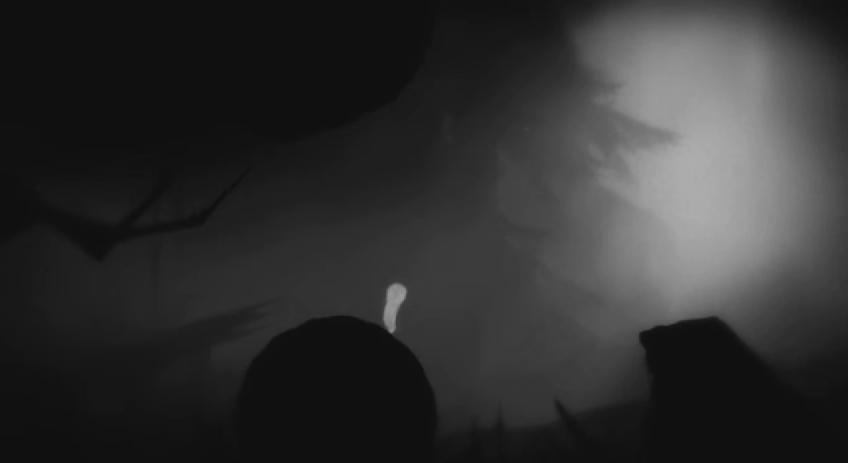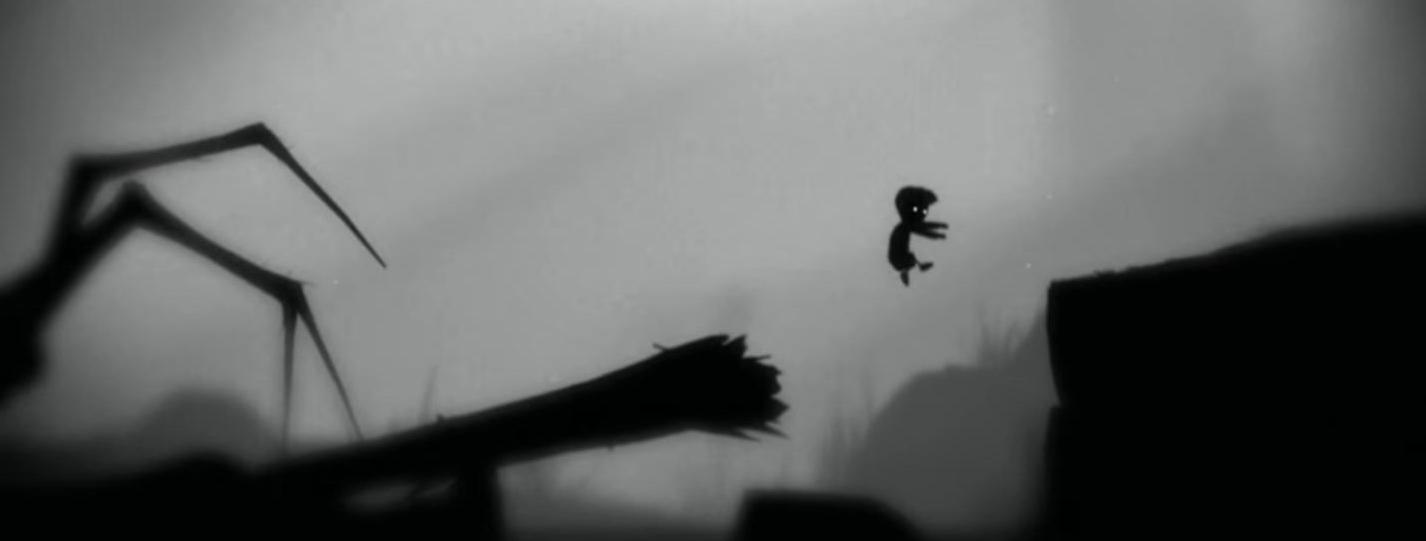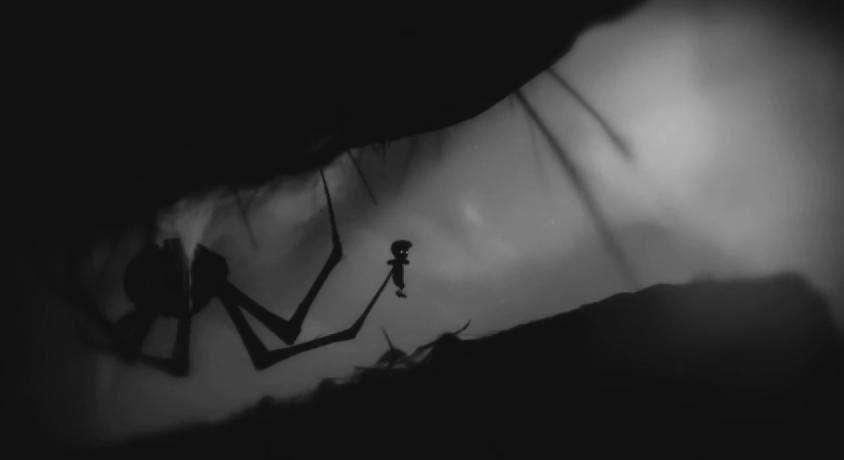Welcome to Defining Moments In Games, where I take some of my favorite games of all time and analyze single moments to see what they do right, and how they leave a lasting impact on the game.This time around, we’re throwing aside big-budget productions and focusing on how little studios can still develop strong moments that stick in the minds of gamers for years. Today, I’ll be reliving a traumatic event from one of my favorite indie-developed games of all time, Playdead’s Limbo.
As usual, this is a completely spoiler-filled write-up. Limbo is a short game that thrives on it’s surprising elements and little things, so any spoilers risk hurting the overall experience. I highly recommend picking this game up and giving it a playthrough before reading this article. No seriously, just go buy it already.
Playdead just announced their second game, called Inside, at this year’s E3. It was a long-awaited reveal that no one knew was finally upon as. Immediately, it was easy to tell it would capture some of the same style and atmosphere of Limbo. But why are so many people in love with Limbo and why would one little game leave people in anticipation for a follow-up?
When you break it down, Limbo is a pretty simple game. There aren’t many mechanics at play. You run, you jump, you climb, you press switches, and you push boxes. That’s just about it. There aren’t a ton of platforming challenges and only a healthy smattering of puzzles. It’s a very short game, but it’s one that lasts long after it’s done.
This is in part to it’s remarkable visuals and open-to-interpretation story. Little details fill the game with mystery and a sense of dread and tension that is unrivaled by a lot of bigger games out there. But there is one moment, or really a series of moments around a singular entity, that stick out in my mind: that f@#*ing spider!
The Scene
Limbo’s world shows plenty signs of life, but we rarely see other living creatures. Sure, there are some of those creepy Lord Of The Flies kids trying to murder you in vicious ways, and occasionally a brain-sucking leech falls on your head and makes you act like a zombie, but other than that, the world seems oddly empty. That is, except for that giant-a** spider you bumped into early on.
We haven’t seen anything or anyone since we woke up in this forest, but suddenly our young hero finds himself with a new obstacle in his path: a towering spider, three times our height. And it’s clearly not willing to move. If you get too close, it shoves a spiked foot through your head like a child-kabob. Clearly, this thing is not to be messed with.
Unless we have to to move on.
Later on, you wander into a cave and find yourself trapped on some webbing on the ground. It’s then that our old friend makes his second appearance, and he isn’t particularly thrilled to see us. I don’t get why he’s so angry and won’t leave us alone, it’s not like we did anything to him! Well, besides tricking him into dropping his leg into a bear trap…
For the first time in the game, we don’t have control of our character. He’s stuck, and the spider approaches. It picks us up with one of it’s legs and quickly weaves the kid into a cocoon of web and plants us on the ceiling. He then just leaves us there and goes off to find more prey. We’re literally left hanging.
But, with a few shakes, we’re able to break free of the ceiling. But not of the web. For the next chunk of game, our hero is completely tied up by spiderwebs, moving in a desperate hop to escape. Just when it looks like we’re out of the woods (the figurative woods, still very much in the actual woods), our spider friend shows up behind us at the worst possible moment. Not that there is a good moment to have a giant spider looking to murder you, but he could have waited until after we made it across this spiky pit…

After rolling violently down a hill, which luckily rips the webbing off of us, the chase is on. The spider is clearly no longer seeking to capture us, but to finish this pesky rodent off for good. After running from the spider, we come across a boulder. Perhaps we can use this to take down this behemoth once and for all? And why not rip a few of it’s legs off for good measure. Now it couldn’t possibly pursue us anymore.
Unless it dragged it’s body towards us using it’s now-single leg! Come on! In one of the most disgusting, yet satisfying, final moments of any antagonist, we’re allowed to tear the final leg off our former eight-legged enemy and put an end to this little battle for survival. The entire thing plays out in only a handful of minutes, but it was thrilling and tense.

Why It Works
Honestly, this wouldn’t have been nearly as cool if it wasn’t for Limbo’s murky black and white art style and foggy atmosphere. This is a case where this would have just been another typical moment in any other game. But somehow, it’s amplified ten-fold by the art direction of the game.
For instance, when you’re picked up by the spider and webbed to the ceiling, you’ll notice something just barely noticeable in the fog of the background. It appears to be another web sack that seems to be roughly the same size as you. It struggles to break free, but simply can’t. The fact this is kept to the background, instead of being a foreground object, gives a sense of depth to this cave. Turning a 2D tunnel into a massive cavern full of captured children to be feasted on by this spider. It makes your villain seem substantially more evil and deadly. This thing is a master of capturing people. It’s done it plenty of times before. What chance do you have of escaping a seasoned predator? All it takes is a little background detail to give you all you need to realize this. It’s not made obvious, it’s not a cutscene of you discovering bodies in spider sacks, it’s a simple, barely-noticeable background detail.
The most striking moment is when the spider returns during your escape from it’s prison. Hoping across a massive boulder, rolling it carefully across a pit full of spikes, something emerges from the blurry edges of the screen. The moment where just the ends of a couple recognizable limbs claw across the ceiling behind you, obscured by the fog, is nothing short of heart-stopping. The timing is perfect, catching you at the most vulnerable moment possible. It immediately returns you to the fear from earlier and forces you to start moving slightly less deliberately, taking more daring jumps, trying frantically to reach safe ground. All the while, the spider slowly becomes more and more visible from the smog behind you. The visual tricks used to make the spider feel as though it’s crawling out of the fog in a 2D game are remarkable.
This is amplified even more when you realize the game has shed yet another traditional element to make this more effective. In most games, a action-packed chase scene like this would be accompanied by an upbeat score. A chase sequence theme would play and we’d be amped up. But Limbo maintains it’s relatively quiet, ambient soundscape. A moody lack of traditional music and sound. Instead, it feels all too real. There would be no chase music if this was really happening, so why should there be here? This just makes everything feel more oppressive and dangerous. It’s not music cues or sound effects telling you it’s time to run, but instinct. You know this thing is going to kill you, and your only option is to run for your life. You also know that everything ahead of you is going to be dangerous, so you have no idea if what you’re running towards is going to be even worse. All of this is achieved by your own mind, instead of tricks by the game makers.
It’s the fact Playdead decided to throw aside all the conventions of most games and focus instead on a more subtle, creeping tension that makes this scene work so well. It’s not over-played or fluffed up. You get exactly what you see. A giant spider and nothing to do but run. No flashy action sequences, just a raw, fearful sprint from a relentless enemy that seems nearly impossible to get off your back. This manages to turn a spider, a pretty common video game enemy, into the most memorable moment of the game.
It’s Impact On The Game
Catching your breathe, you now realize something: that could happen again at any time. Every patch of grass or shadow is now intimidating. Because you have no idea when it might be another creature looking to rip you apart. As if traps and environmental dangers weren’t enough, now we know the game has the potential to throw giant monsters at us too?!
Putting this sequence earlier on in the game, and subsequently ending the spider saga early on as well, allows it to leave an impact on the rest of the game. A lot of games would have had the spider appear early, then maybe pop up a few more times, and finally be finished off towards the end of the game as a final boss. But this all happens quickly, and early on, and allows that lingering fear of giant monsters last for the rest of the game.
Do any more giant monsters appear? Nope. But you’re now constantly on-edge for the rest of the game anyway. It doesn’t matter if there aren’t anymore out there, because the POSSIBILITY they’re out there is enough. This is a very big moment for the game. It sits you down and says “Hey, you’re nothing. You’re a tiny speck of dirt compared to this world. You are not the strongest thing here. You got lucky. And at any moment, you can die. Think about that!”
It’s true. We’re always one step away from being wiped out. But hey, at least we got to rip that d*** spider’s legs off. That was fun.


 …WOOLY DESERVES BETTER LOL!
…WOOLY DESERVES BETTER LOL!